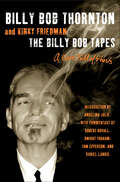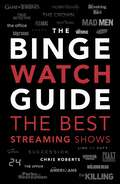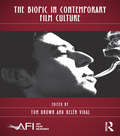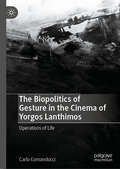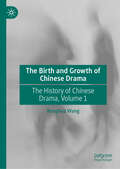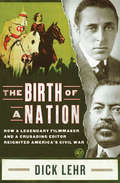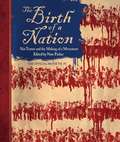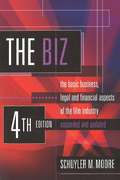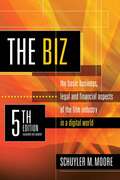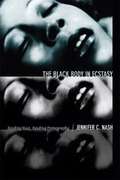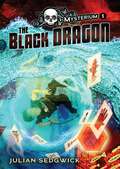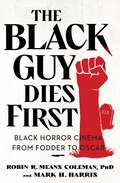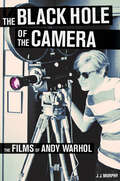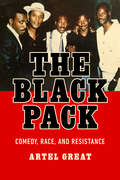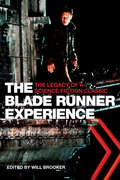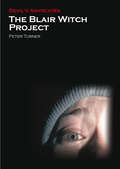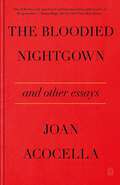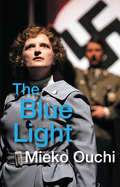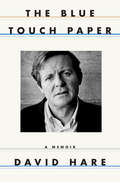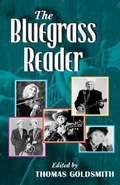- Table View
- List View
The Billy Bob Tapes: A Cave Full of Ghosts
by Kinky Friedman Billy Bob Thornton“One of the more readable, insightful and entertaining celebrity autobiographies in recent memory—a tragicomedy that could be turned into its own movie.” —Chicago Sun-TimesThere is—and could only ever be—one Billy Bob Thornton: actor, musician, Academy Award-winning screenwriter, and accidental Hollywood badass. In The Billy Bob Tapes, he leads us into his Cave Full of Ghosts, spinning colorful tales of his modest (to say the least) Southern upbringing, his bizarre phobias (komodo dragons?), his life, his loves (including his marriage to fellow Oscar winner Angelina Jolie), and, of course, his movie career. Best of all, he’s feeding these truly incredible stories and righteous philosophical rants through his close friend, Kinky Friedman—legendary country music star, bestselling author, would-be politician, and all-around bon vivant. Put these two iconoclasts together and you get a star’s story that’s actually an insightful pop culture manifesto—a hybrid offspring of Born Standing Up with Sh*t My Dad Says.“Mr. Thornton, who grew up in Arkansas, is a gifted storyteller, with an eye for the telling detail and a moving way of blending comedy with tragedy. ”—The New York Times“Rife with Southern gothicisms, delightfully weird digressions, and the sort of 3 a.m. philosophizing that Flannery O’Connor had to make up.” —Austin Chronicle
The Binge Watch Guide: The best television and streaming shows reviewed
by Chris RobertsThe 100 best streaming shows reviewed and rated. You may have viewing time on your hands – this guide will give you ideas for what to watch next, with reviews of more than 100 of the best shows around, from the BBC, ITV, C4, HBO, Amazon Prime, Sky Atlantic, Netflix, Disney+ and more.From The Affair to The X-Files, Fawlty Towers to Fleabag, Parks and Recreation to Peaky Blinders and from Game of Thrones to The Crown.
The Biopic in Contemporary Film Culture (AFI Film Readers)
by Tom Brown Belén VidalThe biographical film or biopic is a staple of film production in all major film industries and yet, within film studies, its generic, aesthetic, and cultural significance has remained underexplored. The Biopic in Contemporary Film Culture fills this gap, conceptualizing the biopic with a particular eye toward the "life" of the genre internationally. New theoretical approaches combine with specially commissioned chapters on contemporary biographical film production in India, Italy, South Korea, France, Russia, Great Britain, and the US, in order to present a selective but well-rounded portrait of the biopic’s place in film culture. From Marie Antoinette to The Social Network, the pieces in this volume critically examine the place of the biopic within ongoing debates about how cinema can and should represent history and "real lives." Contributors discuss the biopic’s grounding in the conventions of the historical film, and explore the genre’s defining traits as well as its potential for innovation. The Biopic in Contemporary Film Culture expands the critical boundaries of this evolving, versatile genre.
The Biopolitics of Gesture in the Cinema of Yorgos Lanthimos: Operations of Life
by Carlo ComanducciThis book establishes a dialogue between Yorgos Lanthimos and Giorgio Agamben as a way of interpreting the “weird” roles, rules, and rituals that define and discipline lives in Lanthimos’s early works, from Kinetta to The Killing of a Sacred Deer. By exploring the resonance between Lanthimos’s cinema and Agamben’s understanding of gesture, this work wants to contribute to a theory of performative power under biopolitical and spectacular modalities of government, focussing in particular on Agamben’s ideas of operativity and inoperativity and on the construction and deconstruction of the white bourgeois, normative, and consensual “formality” of life. In turn, the role gestures play in Lanthimos’s critique of patriarchy and of neoliberal forms of vulnerabilisation is used to question Agamben’s unspoken affinities with contemporary radical feminism and queer theory.
The Birth and Growth of Chinese Drama: The History of Chinese Drama, Volume 1
by Ronghua WangThis is a book of the history of China’s contemporary drama. It provides a panorama of the ups and downs of Chinese drama. It tells how this western art has been adapted to the Chinese context and what it has offered to the world of theatre. It illustrates who the outstanding playwrights are and what great drama they have produced. The book shows how Chinese traditional culture has been blended with this western art form. The book also demonstrates how deeply drama is involve in Chinese politics and daily life.
The Birth of a Nation
by Dick LehrIn a scene at the end of the Civil War, James Trotter, a sergeant in an all-black union regiment, marched into Charleston, South Carolina just as the Kentucky cavalry that included Colonel "Roaring Jake” Griffith fled for their lives. The two men were bit players in the vicious struggle for their country’s future. Fifty years later their sons, Monroe Trotter and D. W. Griffith engaged in a public confrontation that roiled the entire country, pitching black against white, Hollywood against Boston, free speech against censorship - and the focus of the attack was a film that depicted the events of the American Civil War: The Birth of a Nation. The film - which included actors in black face, racist portraits of blacks and heroic portraits of the Ku Klux Klan, and the depiction of the assassination of Abraham Lincoln - was although a silent movie loudly controversial. It was seen eventually by 25 million Americans, and was the first feature film ever to be shown at the White House, for President Wilson. But it sparked riots and lengthy unrest in Boston and, to a lesser extent, in Philadelphia; Chicago, Pittsburgh, Kansas City and Denver, among other cities, banned the movie entirely. The drama was over what America was in 1915, the year of the film’s release. Which of the nation’s cherished ideals - freedom of speech or civil rights for black Americans - would prevail? Through the story of two men, one a technically brilliant film maker, the other an activist journalist, America debated its identity in full public view, up and down the nation. The Birth of A Nation is a classic social history of a country in transition, and a richly characterful account of the principles set in opposition to each other.
The Birth of a Nation
by Dick LehrIn a scene at the end of the Civil War, James Trotter, a sergeant in an all-black union regiment, marched into Charleston, South Carolina just as the Kentucky cavalry that included Colonel "Roaring Jake” Griffith fled for their lives. The two men were bit players in the vicious struggle for their country’s future. Fifty years later their sons, Monroe Trotter and D. W. Griffith engaged in a public confrontation that roiled the entire country, pitching black against white, Hollywood against Boston, free speech against censorship - and the focus of the attack was a film that depicted the events of the American Civil War: The Birth of a Nation. The film - which included actors in black face, racist portraits of blacks and heroic portraits of the Ku Klux Klan, and the depiction of the assassination of Abraham Lincoln - was although a silent movie loudly controversial. It was seen eventually by 25 million Americans, and was the first feature film ever to be shown at the White House, for President Wilson. But it sparked riots and lengthy unrest in Boston and, to a lesser extent, in Philadelphia; Chicago, Pittsburgh, Kansas City and Denver, among other cities, banned the movie entirely. The drama was over what America was in 1915, the year of the film’s release. Which of the nation’s cherished ideals - freedom of speech or civil rights for black Americans - would prevail? Through the story of two men, one a technically brilliant film maker, the other an activist journalist, America debated its identity in full public view, up and down the nation. The Birth of A Nation is a classic social history of a country in transition, and a richly characterful account of the principles set in opposition to each other.
The Birth of a Nation: Nat Turner and the Making of a Movement
by Nate ParkerThis official tie-in to the highly acclaimed film, The Birth of a Nation, surveys the history and legacy of Nat Turner, the leader of one of the most renowned slave rebellions on American soil, while also exploring Turner's relevance to contemporary dialogues on race relations.Based on astounding events in American history, The Birth of a Nation is the epic story of one man championing the spirit of resistance as he leads a rough-and-tumble group into a revolt against injustice and slavery. Breathing new life into a story that has been rife with controversy and prejudice for over two centuries, the film follows the rise of the visionary Virginian slave, Nat Turner. Hired out by his owner to preach to and placate slaves on drought-plagued plantations, Turner eventually transforms into an inspired, impassioned, and fierce anti-slavery leader. Beautifully illustrated with stills from the movie and original illustrations, the book also features an essay by writer/director, Nate Parker, contributions by members of the cast and crew, and commentary by educator Brian Favors and historians Erica Armstrong Dunbar and Daina Ramey Berry who place Nat Turner and the rebellion he led into historical context. The Birth of a Nation reframes the way we think about slavery and resistance as it explores the passion, determination, and faith that inspired Nat Turner to sacrifice everything for freedom.
The Biz: The Basic Business, Legal, and Financial Aspects of the Film Industry
by Schuyler MooreToday's film industry is a legal and financial obstacle course that independent film-makers must learn to master. The most comprehensive guide to negotiating that obstacle course is 'The Biz', a highly accessible overview of the industry's important business, legal and financial aspects. This 4th Edition comprehensively updates all chapters.
The Biz: The Basic Business, Legal, and Financial Aspects of the Film Industry in a Digital World
by Schuyler M. MooreToday's film industry is a legal and financial obstacle course that independent filmmakers must learn to master. The most comprehensive guide to negotiating that obstacle course is The Biz, a highly accessible overview of the industry's important business, legal, and financial aspects.
The Black Body in Ecstasy: Reading Race, Reading Pornography
by Jennifer Christine NashIn The Black Body in Ecstasy, Jennifer C. Nash rewrites black feminism's theory of representation. Her analysis moves beyond black feminism's preoccupation with injury and recovery to consider how racial fictions can create a space of agency and even pleasure for black female subjects. Nash's innovative readings of hardcore pornographic films from the 1970s and 1980s develop a new method of analyzing racialized pornography that focuses on black women's pleasures in blackness: delights in toying with and subverting blackness, moments of racialized excitement, deliberate enactments of hyperbolic blackness, and humorous performances of blackness that poke fun at the fantastical project of race. Drawing on feminist and queer theory, critical race theory, and media studies, Nash creates a new black feminist interpretative practice, one attentive to the messy contradictions--between delight and discomfort, between desire and degradation--at the heart of black pleasures.
The Black Dragon (Mysterium #1)
by Julian SedgwickTwelve-year-old Danny Woo had an unusual childhood. His parents were the star performers in the Mysterium circus—and they taught Danny plenty of tricks. But his parents' skills couldn't save them from dying in a suspicious fire. Now Danny and his aunt Laura, a journalist, are heading to Hong Kong so Laura can research the dangerous gang called the Black Dragon. Almost immediately, she's kidnapped and Danny realizes that the gang may be connected to his family's past. With the help of an old friend, Danny tries to free his aunt, and he uses every trick he knows to face off against the international criminal network that might be responsible for his parents' deaths.
The Black Guy Dies First: Black Horror Cinema from Fodder to Oscar
by Robin R. Means Coleman Mark H. HarrisA definitive and surprising exploration of the history of Black horror films, after the rising success of Get Out, Candyman, and Lovecraft Country from creators behind the acclaimed documentary, Horror Noire.The Black Guy Dies First explores the Black journey in modern horror cinema, from the fodder epitomized by Spider Baby to the Oscar-winning cinematic heights of Get Out and beyond. This eye-opening book delves into the themes, tropes, and traits that have come to characterize Black roles in horror since 1968, a year in which race made national headlines in iconic moments from the enactment of the 1968 Civil Rights Act and Martin Luther King Jr.&’s assassination in April. This timely book is a must-read for cinema and horror fans alike.
The Black Hole of the Camera: The Films of Andy Warhol
by J. J. MurphyAndy Warhol, one of the twentieth century’s major visual artists, was a prolific filmmaker who made hundreds of films, many of them—Sleep, Empire, Blow Job, The Chelsea Girls, and Blue Movie—seminal but misunderstood contributions to the history of American cinema. In the first comprehensive study of Warhol’s films, J.J. Murphy provides a detailed survey and analysis. He discusses Warhol’s early films, sound portraits, involvement with multimedia (including The Velvet Underground), and sexploitation films, as well as the more commercial works he produced for Paul Morrissey in the late 1960s and early 1970s. Murphy’s close readings of the films illuminate Warhol’s brilliant collaborations with writers, performers, other artists, and filmmakers. The book further demonstrates how Warhol’s use of the camera transformed the events being filmed and how his own unique brand of psychodrama created dramatic tension within the works.
The Black Pack: Comedy, Race, and Resistance
by Artel GreatThe Black Pack: Comedy, Race & Resistance is the first book to chronicle the untold history behind the iconic collaborations between a legendary group of comedians—Eddie Murphy, Paul Mooney, Keenen Ivory Wayans, Robert Townsend, and Arsenio Hall—who joined forces as the “Black Pack” in the late 1980s to create a series of socially-charged comedies that revolutionized popular culture and transformed American comedy. Working together as writers, directors, producers, actors, and consultants, the Black Pack created some of the most provocative and enduring Black films and television shows of the twentieth century, including classic productions like In Living Color, Coming to America, Hollywood Shuffle, and The Arsenio Hall Show. The Black Pack collective was armed with a signature comedic style which combined politically-Black satire with edgy social humor that entertained millions, shattered box-office records, and slyly critiqued America’s racial condition. Amid escalating social tensions in the 1980s, the Black Pack’s comedic output transformed anger into art, wielding the cloak of humor as a rebellious tool to confront unjust business practices in Hollywood and challenge racial narratives embedded in American culture. Their work empowered unapologetically Black voices and expanded creative possibilities for Black artists in the entertainment industry. In The Black Pack, Artel Great delivers the most comprehensive analysis of this groundbreaking comedy collective, uncovering how the group’s socially and politically-charged humor defied systemic barriers to achieve unprecedented commercial success and establish a cultural legacy that continues to inspire media creators today and across new generations.
The Black Radical Tragic: Performance, Aesthetics, and the Unfinished Haitian Revolution (America and the Long 19th Century #2)
by Jeremy Matthew Glick2017 Nicolás Guillén Outstanding Book Award presented by the Caribbean Philosophical AssociationAs the first successful revolution emanating from a slave rebellion, the Haitian Revolution remains an inspired site of investigation for a remarkable range of artists and activist-intellectuals in the African Diaspora.In The Black Radical Tragic, Jeremy Matthew Glick examines twentieth-century performances engaging the revolution as laboratories for political thinking. Asking readers to consider the revolution less a fixed event than an ongoing and open-ended history resonating across the work of Atlantic world intellectuals, Glick argues that these writers use the Haitian Revolution as a watershed to chart their own radical political paths, animating, enriching, and framing their artistic and scholarly projects. Spanning the disciplines of literature, philosophy, and political thought, The Black Radical Tragic explores work from Lorraine Hansberry, Sergei Eisenstein, Edouard Glissant, Malcolm X, and others, ultimately enacting a speculative encounter between Bertolt Brecht and C.L.R. James to reconsider the relationship between tragedy and revolution. In its grand refusal to forget, The Black Radical Tragic demonstrates how the Haitian Revolution has influenced the ideas of freedom and self-determination that have propelled Black radical struggles throughout the modern era.
The Blade Runner Experience: The Legacy of a Science Fiction Classic
by Will BrookerSince its release in 1982, Ridley Scott's Blade Runner, based on Philip K. Dick's novel Do Androids Dream of Electric Sheep?, has remained a cult classic through its depiction of a futuristic Los Angeles; its complex, enigmatic plot; and its underlying questions about the nature of human identity. The Blade Runner Experience: The Legacy of a Science Fiction Classic examines the film in a broad context, examining its relationship to the original novel, the PC game, the series of sequels, and the many films influenced by its style and themes. It investigates Blade Runner online fandom and asks how the film's future city compares to the present-day Los Angeles, and it revisits the film to pose surprising new questions about its characters and their world.
The Blade Runner Experience: The Legacy of a Science Fiction Classic
by Will BrookerSince its release in 1982, Ridley Scott's Blade Runner, based on Philip K. Dick's novel Do Androids Dream of Electric Sheep?, has remained a cult classic through its depiction of a futuristic Los Angeles; its complex, enigmatic plot; and its underlying questions about the nature of human identity. The Blade Runner Experience: The Legacy of a Science Fiction Classic examines the film in a broad context, examining its relationship to the original novel, the PC game, the series of sequels, and the many films influenced by its style and themes. It investigates Blade Runner online fandom and asks how the film's future city compares to the present-day Los Angeles, and it revisits the film to pose surprising new questions about its characters and their world.
The Blair Witch Project
by Peter TurnerTells the story of the film from conception and production to audience response.
The Blair Witch Project
by Peter TurnerFew films have had the influence and impact of The Blair Witch Project (1999). Its arrival was a horror cinema palette cleanser after a decade of serial killers and postmodern intertextuality, a bare bones 'found footage' trend setter. In this Devil's Advocate, Peter Turner tells the story of the film from his conception and production then provides a unique analysis of the techniques used, their appeal to audiences and the themes that helped make the film such an international hit, including the pionerring internet marketing.
The Bloodied Nightgown and Other Essays
by Joan AcocellaA collection of the New Yorker critic’s finest essays, which examine the books that reveal and record our world.Joan Acocella was “one of our finest cultural critics” (Edward Hirsch), and she had the rare ability to examine literature and unearth the lives contained within it—its authors, its subjects, and the communities from which it springs. In her hands, arts criticism was a celebration and an investigation, and her essays pulse with unadulterated enthusiasm. As Kathryn Harrison wrote in The New York Times Book Review, “Hers is a vision that allows art its mystery but not its pretensions, to which she is acutely sensitive. What better instincts could a critic have?”The Bloodied Nightgown and Other Essays gathers twenty-four essays from the final decade and a half of Acocella’s career, as well as an introduction that frames her simple preoccupations: “life and art.” In agile, inspired prose, she moves from J. R. R. Tolkien’s translation of Beowulf to the life of Richard Pryor, from surveying profanity to untangling the book of Job. Her appetite (and reading list) knew no bounds. This collection is a joy and a revelation, a library in itself, and Acocella is our dream companion among its shelves.Includes 25 black-and-white images
The Blue Light
by Mieko OuchiLeni Riefenstahl, one hundred years old, is in the office of a young female Hollywood studio executive. Leni’s reason to be there is clear: to make one last desperate pitch to direct her first feature film in fifty years. A thought-provoking contemplation on art, politics, and the seduction of fascism, and a theatrical examination of a woman who danced one perfect dance with the devil and forever changed the way films are made.Leni Riefenstahl was one of the most remarkable and controversial women of the twentieth century. Dancer, actor, photographer, and filmmaker, Riefenstahl caught the eye of Adolf Hitler with her prodigious first film: The Blue Light. A cinematic innovator, her decision to direct Triumph of the Will, got her blacklisted as a filmmaker until her death in 2003 at 101, unrepentant and mostly forgotten.
The Blue Touch Paper: A Memoir
by David Hare"Frank, moving, and beguiling, The Blue Touch Paper is the fascinating story of becoming a writer in the 1960s and 70s when Britain was changing even faster than the author."--Joan Didion David Hare has long been one of Britain's best-known screenwriters and dramatists. He's the author of more than thirty acclaimed plays that have appeared on Broadway, in the West End, and at the National Theatre. He wrote the screenplays for the hugely successful films The Hours, Plenty, and The Reader. Most recently, his play Skylight won the 2015 Tony Award for Best Revival on Broadway. Now, in his debut work of autobiography, "Britain's leading contemporary playwright" (Sunday Times) offers a vibrant and affecting account of becoming a writer amid the enormous flux of postwar England. In his customarily dazzling prose and with great warmth and humor, he takes us from his university days at Cambridge to the swinging 1960s, when he cofounded the influential Portable Theatre in London and took a memorable road trip across America, to his breakthrough successes as a playwright amid the political ferment of the '70s and the moment when Margaret Thatcher came to power at the end of the decade. Through it all, Hare sets the progress of his own life against the dramatic changes in postwar England, in which faith in hierarchy, religion, empire, and the public good all withered away. Filled with indelible glimpses of such figures as Alfred Hitchcock, Laurence Olivier, Tennessee Williams, Helen Mirren, and Joseph Papp, The Blue Touch Paper is a powerful evocation of a society in transition and a writer in the making.
The Bluegrass Guitar Style of Charles Sawtelle
by Daniel MillerBook description from the Flatpicking Guitar magazine website (where I bought it!) Charles Sawtelle is one of the most innovative guitar players in bluegrass history. His bluesy syncopated solos with the popular bluegrass band Hot Rize proved true the famous saying 'less is more.' Charles is a true master of tone, timing, and taste in bluegrass guitar playing and his exciting and innovative solos have thrilled bluegrass fans around the world. This comprehensive book provides you with a Sawtelle biography, an extensive interview with Charles, a section on Charles' rhythm style, 27 transcriptions of Sawtelle solos in both standard notation and tablature, with notes accompanying each solo transcription and dozens of photographs of Charles and Hot Rize. All fans of Hot Rize will love this book. Level: Intermediate, Advanced. Even though the musical notation and tablature could not be reproduced in this version, there is much text which helps to reveal the nature of Sawtelle's guitar playing. Also, many of the big names in today's bluegrass tell why they think he was one of the best. (Sawtelle passed away in 1999.)
The Bluegrass Reader
by Thomas GoldsmithLike rock 'n' roll, bluegrass exploded out of a post-World War II atmosphere in which more Americans opened their ears to more different kinds of music than ever before. All around the country musicians were searching for new sounds and approaches: country blues went fully electric in Chicago, bebop boiled over as jazz hit the hippest notes yet, and country music followed Hank Williams into new, sexier, harder-hitting territory. The developments in bluegrass proved every bit as galvanic. In The Bluegrass Reader, Thomas Goldsmith joins his insights as a journalist with a lifetime of experience in bluegrass to capture the full story of this dynamic and beloved music. Inspired by the question, what articles about bluegrass would you want to have with you on a desert island? he has assembled a captivating, fun-to-read collection that brings together a wide range of the very best in bluegrass writing.
